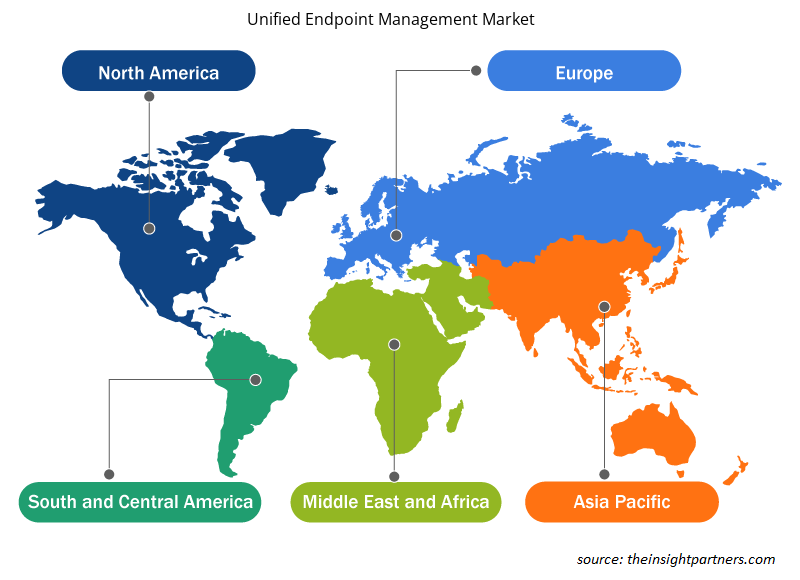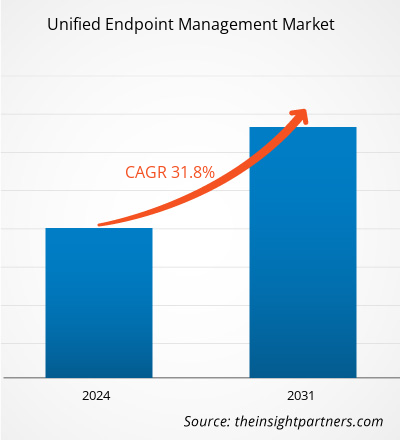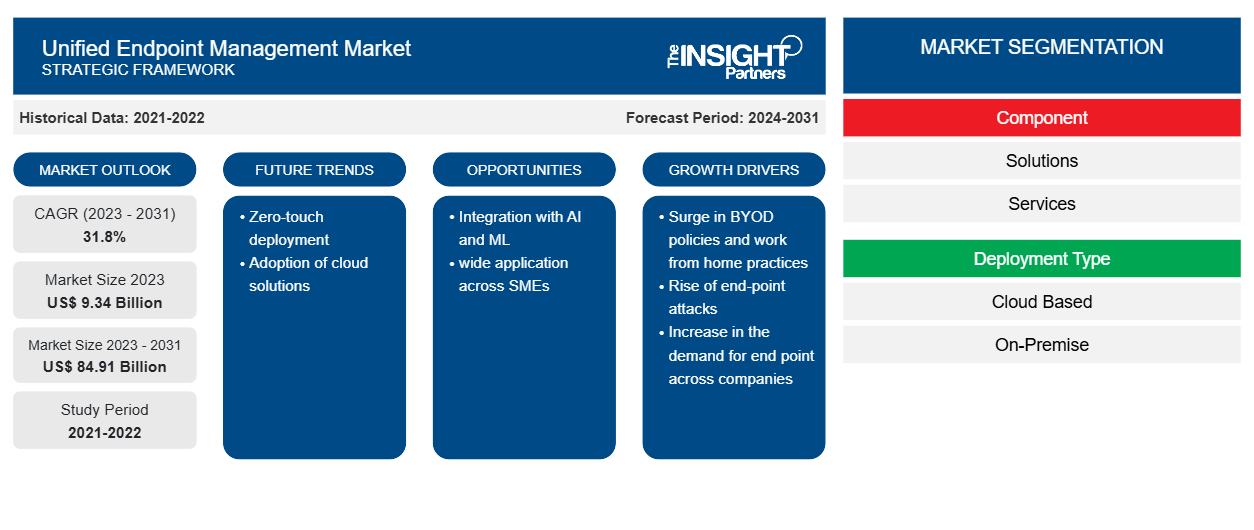Se espera que el tamaño del mercado de gestión unificada de puntos finales alcance los 84.910 millones de dólares en 2031, frente a los 9.340 millones de dólares en 2023. Se estima que el mercado registrará una CAGR del 31,8 % durante el período 2023-2031. Es probable que la implementación sin intervención y la adopción de soluciones basadas en la nube en las empresas traigan nuevas tendencias al mercado.
Análisis del mercado de la gestión unificada de puntos finales
La creciente demanda de una gestión eficiente y de alta seguridad de los puntos finales y la creciente tendencia de una fuerza laboral móvil impulsan la adopción de soluciones de gestión unificada de puntos finales en empresas de distintos tamaños. Con la creciente tendencia a la digitalización, los lugares de trabajo inteligentes y la automatización, se prevé que la demanda de soluciones de gestión unificada de puntos finales aumente rápidamente en los próximos años.
Los avances en las tecnologías de la información y las aplicaciones digitales han aumentado los recursos de TI en todo el mundo. Según el informe de Cisco, para finales de 2021 habrá más de 27.100 millones de dispositivos conectados a Internet. Las empresas están adoptando cada vez más modelos de gama alta para cumplir con los requisitos de hardware de los sistemas operativos actualizados, como Windows 10 y ChromeOS. Con el aumento del uso de terminales como portátiles, tabletas, teléfonos móviles y ordenadores de sobremesa en las empresas, aumenta la necesidad de gestionar estos terminales desde una única plataforma, lo que da lugar a un aumento de la demanda de soluciones unificadas. La creciente tendencia a implementar políticas que permitan a los dispositivos personales acceder a los datos corporativos es otro factor que impulsa el mercado.
Descripción general del mercado de gestión unificada de puntos finales
Las herramientas de gestión unificada de puntos finales (UEM) que ofrecen varias empresas permiten a los clientes gestionar y proteger todos los servidores, dispositivos y puntos finales de una organización desde una consola unificada. También es una combinación de varias soluciones, como la gestión de la movilidad empresarial , la gestión de contenido móvil, la gestión de aplicaciones móviles, la gestión de dispositivos móviles y la gestión de clientes. Las soluciones de gestión unificada de puntos finales cubren diferentes plataformas (como Windows, macOS, iOS, Android y Wear OS) en varios dispositivos, incluidos equipos de escritorio, portátiles, teléfonos inteligentes, tabletas y wearables. Estas soluciones admiten todos los casos de uso de movilidad en las organizaciones, desde dispositivos corporativos, diseñados específicamente o compartidos hasta dispositivos BYOD. Los principales beneficios de las soluciones de gestión unificada de puntos finales incluyen la gestión de puntos finales, la gestión de perfiles de usuario, los paneles de control, los informes, la gestión de dispositivos móviles y la aplicación de parches y seguridad de puntos finales. Debido a todas las características y beneficios, estas soluciones y los servicios relacionados se están volviendo cada vez más populares entre las industrias de TI y telecomunicaciones, atención médica, BFSI, gobierno, comercio minorista y otras industrias de usuarios finales.
Personalice este informe según sus necesidades
Obtendrá personalización en cualquier informe, sin cargo, incluidas partes de este informe o análisis a nivel de país, paquete de datos de Excel, así como también grandes ofertas y descuentos para empresas emergentes y universidades.
-
Obtenga las principales tendencias clave del mercado de este informe.Esta muestra GRATUITA incluirá análisis de datos, desde tendencias del mercado hasta estimaciones y pronósticos.
Impulsores y oportunidades del mercado de la gestión unificada de puntos finales
Aumento de las políticas BYOD y prácticas de trabajo desde casa
El inicio de la pandemia de COVID-19 provocó una mayor adopción del modelo de trabajo desde casa, lo que dio lugar a un aumento de las políticas BYOD en varias organizaciones. BYOD permite a los empleados utilizar dispositivos personales, como tabletas, computadoras y teléfonos inteligentes, para acceder a datos, recursos y aplicaciones confidenciales de la empresa. Según el informe de Cybersecurity Insiders 2021, en total, el 82% de las organizaciones utilizan BYOD. Una encuesta realizada por 271 profesionales de la ciberseguridad descubrió que el 70% de las organizaciones hacen que los empleados lleven sus propios dispositivos al lugar de trabajo. BYOD también se aplica a los contratistas (26% de las organizaciones), socios (21%), clientes (18%) y proveedores (14%). Además, según Jamf, en julio de 2023, aproximadamente el 75% de las personas usaban dispositivos personales para el trabajo de oficina, lo que resultó en un aumento del 34% en la productividad; además, las organizaciones pueden ahorrar aproximadamente US$ 250 por empleado con una política BYOD más estipendio. La gestión unificada de puntos finales ayuda a gestionar las políticas BYOD de las organizaciones y proporciona medidas de seguridad sólidas, como el cifrado y los controles de acceso seguros, que son cruciales para proteger los datos corporativos en los dispositivos personales. Además, los lugares de trabajo abarcan una combinación de trabajadores en la oficina, híbridos y remotos que utilizan cada vez más sus dispositivos personales para trabajar desde cualquier lugar. Por ejemplo, a diciembre de 2022, según el "Instituto Nacional de Normas y Tecnología", más del 95% de las organizaciones permitían a los empleados utilizar sus propios dispositivos para trabajar desde casa. Además, según Finance Online, la pandemia de COVID-19 llevó al 85% de las empresas a implementar políticas BYOD. La creciente implementación de BYOD presiona a las organizaciones para que supervisen el trabajo remoto general de los empleados, ya que ha aumentado la diversidad de dispositivos que acceden a las redes corporativas. Las soluciones de gestión unificada de puntos finales proporcionan una gestión centralizada de todos los puntos finales. Por tanto, el aumento de las políticas BYOD y las prácticas de trabajo desde casa impulsa la demanda de soluciones de gestión unificada de puntos finales, lo que impulsa el crecimiento del mercado.
Integración con Inteligencia Artificial y Machine Learning
Las tecnologías avanzadas están cambiando rápidamente la forma en que opera el sector de TI. Las soluciones de gestión unificada de puntos finales utilizan el poder de la inteligencia artificial y las integraciones de aprendizaje automático para ampliar la estrategia de seguridad general con análisis contextuales y conocimientos más profundos. Con metodologías de vanguardia, los equipos de seguridad pueden recibir sugerencias sobre alertas, políticas de la industria, amenazas maliciosas, etc., que ayudan a impulsar la productividad y proteger su entorno. La seguridad basada en el aprendizaje automático proporciona una arquitectura de confianza cero que utiliza una autorización multifactor eficiente y otros derechos de autenticación, cifrado, análisis y nivel de sistema de archivos para evitar la pérdida de datos críticos. Además, al aplicar reglas de acceso dinámicas basadas en los dispositivos, la identidad y el contexto del usuario, es posible garantizar que solo las aplicaciones y los usuarios autorizados puedan acceder a la superficie de protección.
La mayoría de los proveedores de gestión unificada de puntos finales están incorporando IA y ML en sus líneas de productos para mejorar su valor y diferenciar sus ofertas. La gestión integrada de puntos finales basada en IA proporciona un enfoque generalizado para la gestión de dispositivos que puede mejorar la seguridad. Al utilizar algoritmos de IA para automatizar muchas de las tareas asociadas con la gestión de dispositivos de puntos finales, las organizaciones pueden reducir el riesgo de violaciones de seguridad. Además, al proporcionar información en tiempo real sobre el estado del dispositivo y los patrones de uso, la gestión unificada de puntos finales basada en IA puede ayudar a las organizaciones a priorizar los problemas y tomar medidas antes de que se conviertan en problemas importantes. Además, varias empresas están integrando IA y ML con la gestión unificada de puntos finales, incluida Blackberry. Por lo tanto, es probable que la integración de la inteligencia artificial y el aprendizaje automático con las soluciones de gestión unificada de puntos finales cree nuevas oportunidades para el crecimiento del mercado durante el período de pronóstico.
Análisis de segmentación del informe de mercado de gestión unificada de puntos finales
Los segmentos clave que contribuyeron a la derivación del análisis del mercado de gestión unificada de puntos finales soncomponente, implementación, plataforma, tamaño de la organización, usuario final y geografía.
- Según los componentes, el mercado se divide en soluciones y servicios. El segmento de soluciones dominó el mercado en 2023.
- En términos de implementación, el mercado de gestión unificada de puntos finales se divide en uno basado en la nube y otro en las instalaciones. El segmento basado en la nube dominó el mercado en 2023.
- En términos de plataforma, el mercado de gestión unificada de puntos finales se divide en dispositivos móviles y de escritorio. El segmento de escritorio tuvo una mayor participación en el mercado en 2023.
- Por tamaño de organización, el mercado de gestión unificada de puntos finales se divide en pymes y grandes empresas. El segmento de grandes empresas dominó el mercado en 2023.
- En términos de usuario final, el mercado está segmentado en BFSI, TI y telecomunicaciones, atención médica, automoción, fabricación, venta minorista y otros. El segmento de TI y telecomunicaciones dominó el mercado en 2023.
Análisis de la cuota de mercado de la gestión unificada de puntos finales por geografía
El mercado de gestión unificada de puntos finales está segmentado en cinco regiones principales: América del Norte, Europa, Asia Pacífico (APAC), Oriente Medio y África (MEA) y América del Sur y Central. América del Norte dominó el mercado en 2023, seguida de Europa y APAC.
El mercado de gestión unificada de puntos finales en América del Norte está creciendo significativamente debido a la creciente inversión de las empresas en tecnologías avanzadas para simplificar sus operaciones. Además, la presencia de una gran cantidad de proveedores de gestión unificada de puntos finales y sus esfuerzos constantes por brindar soluciones de seguridad y capacidades de gestión de puntos finales de alta calidad impulsan el crecimiento del mercado en América del Norte. Además, la disponibilidad y adopción tempranas de herramientas de seguridad digital en toda la región desempeñan un papel importante en el impulso de la adopción de soluciones de gestión unificada de puntos finales.
Perspectivas regionales del mercado de gestión unificada de puntos finales
Los analistas de Insight Partners explicaron en detalle las tendencias y los factores regionales que influyen en el mercado de gestión unificada de puntos finales durante el período de pronóstico. Esta sección también analiza los segmentos y la geografía del mercado de gestión unificada de puntos finales en América del Norte, Europa, Asia Pacífico, Oriente Medio y África, y América del Sur y Central.

- Obtenga los datos regionales específicos para el mercado de gestión unificada de puntos finales
Alcance del informe de mercado de gestión unificada de puntos finales
| Atributo del informe | Detalles |
|---|---|
| Tamaño del mercado en 2023 | US$ 9.34 mil millones |
| Tamaño del mercado en 2031 | US$ 84,91 mil millones |
| CAGR global (2023 - 2031) | 31,8% |
| Datos históricos | 2021-2022 |
| Período de pronóstico | 2024-2031 |
| Segmentos cubiertos |
Por componente
|
| Regiones y países cubiertos |
América del norte
|
| Líderes del mercado y perfiles de empresas clave |
|
Densidad de actores del mercado de gestión unificada de puntos finales: comprensión de su impacto en la dinámica empresarial
El mercado de gestión unificada de puntos finales está creciendo rápidamente, impulsado por la creciente demanda de los usuarios finales debido a factores como la evolución de las preferencias de los consumidores, los avances tecnológicos y una mayor conciencia de los beneficios del producto. A medida que aumenta la demanda, las empresas amplían sus ofertas, innovan para satisfacer las necesidades de los consumidores y aprovechan las tendencias emergentes, lo que impulsa aún más el crecimiento del mercado.
La densidad de actores del mercado se refiere a la distribución de las empresas o firmas que operan dentro de un mercado o industria en particular. Indica cuántos competidores (actores del mercado) están presentes en un espacio de mercado determinado en relación con su tamaño o valor total de mercado.
Las principales empresas que operan en el mercado de gestión unificada de puntos finales son:
- Sistemas de movilidad 42Gears Pvt Ltd.
- BlackBerry Ltd
- Matrix42 AG
- MobileIron Inc
- Ivanti
- Sistemas Citrix Inc.
Descargo de responsabilidad : Las empresas enumeradas anteriormente no están clasificadas en ningún orden particular.

- Obtenga una descripción general de los principales actores clave del mercado de gestión unificada de puntos finales
Noticias y desarrollos recientes del mercado de gestión unificada de puntos finales
El mercado de la gestión unificada de puntos finales se evalúa mediante la recopilación de datos cualitativos y cuantitativos a partir de una investigación primaria y secundaria, que incluye importantes publicaciones corporativas, datos de asociaciones y bases de datos. A continuación, se enumeran algunos de los avances en el mercado de la gestión unificada de puntos finales:
- HCL Software, líder mundial en soluciones de software empresarial, anunció el lanzamiento de sus soluciones BigFix Workspace y Enterprise, que revolucionan la gestión de puntos finales y la automatización de la seguridad para organizaciones de todo el mundo. Con el objetivo de mejorar la experiencia digital de los empleados y garantizar un cumplimiento normativo perfecto, estas innovadoras ofertas redefinen la forma en que las empresas abordan la gestión de puntos finales en un panorama dinámico.
(Fuente: HCL Software, comunicado de prensa, marzo de 2024)
- BlackBerry Limited, el pionero en la gestión de movilidad empresarial, anunció dos importantes innovaciones en gestión unificada de puntos finales (UEM): BlackBerry UEM at the Edge y BlackBerry UEM para IoT.
(Fuente: BlackBerry Limited, comunicado de prensa, octubre de 2023)
Informe de mercado sobre gestión unificada de puntos finales: cobertura y resultados
El informe "Tamaño y pronóstico del mercado de gestión unificada de puntos finales (2021-2031)" proporciona un análisis detallado del mercado que cubre las áreas mencionadas a continuación:
- Tamaño y pronóstico del mercado de gestión unificada de puntos finales a nivel global, regional y nacional para todos los segmentos clave del mercado cubiertos bajo el alcance
- Tendencias del mercado de gestión unificada de puntos finales, así como dinámicas del mercado, como impulsores, restricciones y oportunidades clave
- Análisis PEST y FODA detallados
- Análisis del mercado de gestión unificada de puntos finales que abarca las tendencias clave del mercado, el marco global y regional, los principales actores, las regulaciones y los desarrollos recientes del mercado
- Análisis del panorama de la industria y de la competencia que abarca la concentración del mercado, el análisis de mapas de calor, los actores destacados y los desarrollos recientes para el mercado de gestión unificada de puntos finales
- Perfiles detallados de empresas
- Análisis histórico (2 años), año base, pronóstico (7 años) con CAGR
- Análisis PEST y FODA
- Tamaño del mercado, valor/volumen: global, regional y nacional
- Industria y panorama competitivo
- Conjunto de datos de Excel
Informes recientes
Informes relacionados
Testimonios
Razón para comprar
- Toma de decisiones informada
- Comprensión de la dinámica del mercado
- Análisis competitivo
- Información sobre clientes
- Pronósticos del mercado
- Mitigación de riesgos
- Planificación estratégica
- Justificación de la inversión
- Identificación de mercados emergentes
- Mejora de las estrategias de marketing
- Impulso de la eficiencia operativa
- Alineación con las tendencias regulatorias























 Obtenga una muestra gratuita para - Mercado de gestión unificada de puntos finales
Obtenga una muestra gratuita para - Mercado de gestión unificada de puntos finales